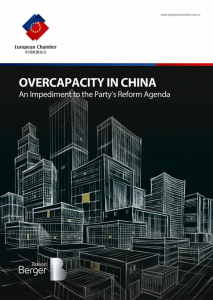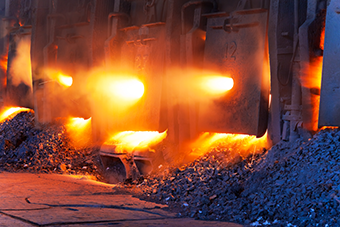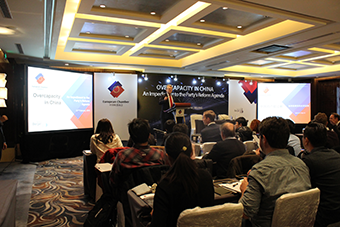 On 22nd February, 2016, the European Chamber of Commerce in China released its second major study on overcapacity in China’s industrial economy. Overcapacity in China: An Impediment to the Party’s Reform Agenda provides a detailed examination of the causes and consequences of serious overcapacity in eight key industries: crude steel, electrolytic aluminium, cement, refining, chemicals, flat glass, shipbuilding, and paper and paperboard. The new report explains how central government efforts to address excessive production capacity have so far been ineffectual, due to regional protectionism, weak regulatory enforcement, low resource pricing, misdirected investment, inadequate protection of intellectual property rights and an emphasis on market share. It also provides recommendations that should be taken by the Chinese Government to address this serious problem.
On 22nd February, 2016, the European Chamber of Commerce in China released its second major study on overcapacity in China’s industrial economy. Overcapacity in China: An Impediment to the Party’s Reform Agenda provides a detailed examination of the causes and consequences of serious overcapacity in eight key industries: crude steel, electrolytic aluminium, cement, refining, chemicals, flat glass, shipbuilding, and paper and paperboard. The new report explains how central government efforts to address excessive production capacity have so far been ineffectual, due to regional protectionism, weak regulatory enforcement, low resource pricing, misdirected investment, inadequate protection of intellectual property rights and an emphasis on market share. It also provides recommendations that should be taken by the Chinese Government to address this serious problem.
Overcapacity, which is defined as the difference between production capacity and actual production, is a topic of long-standing interest to the European Chamber. In 2009, we were one of the very first organisations to publicly raise this subject in a major report. In the autumn of 2015, due to a notable deterioration of the situation, the Chamber decided to revisit the topic, examining subsequent developments that have taken place over the course of the last six and a half years.
Within hours of its release the report had garnered in-depth coverage from the most prominent international and domestic media as well as keen interest from European and Chinese officials, industry groups and international institutions.
Why overcapacity?
 With European businesses facing so many other pressing challenges in China, you may wonder why overcapacity merited another standalone study. Examples from China’s crude steel, aluminium and cement industries illustrate why: steel production has become completely untethered from real market demand, and is now more than double the combined production of the four next leading producers: Japan, India, the United States (US) and Russia; in China’s aluminium industry, 60 per cent of production capacity has negative cash flow; and, according to data from China’s National Bureau of Statistics and the US Geological Survey, in just two years—2011 and 2012—China produced as much cement as the US did during the entire 20th century.
With European businesses facing so many other pressing challenges in China, you may wonder why overcapacity merited another standalone study. Examples from China’s crude steel, aluminium and cement industries illustrate why: steel production has become completely untethered from real market demand, and is now more than double the combined production of the four next leading producers: Japan, India, the United States (US) and Russia; in China’s aluminium industry, 60 per cent of production capacity has negative cash flow; and, according to data from China’s National Bureau of Statistics and the US Geological Survey, in just two years—2011 and 2012—China produced as much cement as the US did during the entire 20th century.
Generally speaking, utilisation rates below 80 per cent are taken to denote overcapacity, with rates of 75 per cent or lower indicating serious overcapacity. While the calculation of utilisation rates for chemicals and shipbuilding is more challenging, in 2014, five of the six other industries examined had utilisation rates in the range of 66 to 79 per cent.[1] In the chemicals industry, utilisation rates for nine out of 16 products were also below 70 per cent, with an additional four having rates in the range of 70-79 per cent. Paper and paperboard, with a utilisation rate of 84 per cent, is the one industry examined that is an exception. However, this represented a six-point fall from 2008, and with major investments continuing to be made in this industry, despite low demand growth, the utilisation rate is expected to continue to decline.
Consequences of overcapacity for China
With the scale of these industries also growing significantly since 2008, utilisation rates by no means tell the whole story. For example, absolute overcapacity in China’s crude steel industry grew from 132 million tonnes in 2008, to 327 million tonnes in 2014. In cement it almost doubled as well, growing from 450 million tonnes to 850 million tonnes during the same period. The list goes on.
Ultimately, many companies in these industries are caught in a vicious cycle of low tech and low-value-add production. Thin profit margins and fierce competition also ensure that few can afford to invest in R&D or other measures that would enable them to adjust their focus toward high-value-add products. With overcapacity frequently resulting in trade tensions and tariffs being applied by other countries in industries like steel and electrolytic aluminium, China is clearly the primary victim.
Unfortunately, the fact that there are so many companies that continue to produce goods for which there is no market-driven demand amounts to an enormous misallocation of land, labour and capital. As these factors of production could be directed toward more productive uses, this currently serves as an impediment to China’s economic growth and modernisation. This sentiment was echoed in a speech given by Levin Zhu, former head of China International Capital Corporation and son of former Premier Zhu Rongji, on 16th October, 2015, in Singapore. He stated that many of the attempts to stimulate China’s economy through investment had been inefficient and that, as a result, for the country to meet its long-term potential it needed fundamental economic restructuring, not rebalancing.[2]
Efforts to date
So what is to be done? The Chinese Government has clearly demonstrated that it understands the scale of the problem. As early as 26th August, 2009, the State Council released a statement noting that overcapacity had become a serious problem in many industries and that many local governments were continuing to expand capacity “blindly” and make “duplicated” investments without considering the mid- and long-term implications, and not just in traditional industries such as steel and cement.[3]
In response to the growing threat posed by overcapacity, the State Council revised its policy targets with the goal of reducing any potential negative impacts such as factory closures, job losses and mounting bad bank loans.
Since the State Council’s August 2009 statement, some actions have subsequently been taken in an attempt to ensure that the cost of production inputs is better aligned with market demand:
- In 2012, the National Development and Reform Commission introduced a progressive electricity pricing system for aluminium producers.
- In October 2013, and in advance of the Third Plenum, the State Council introduced price reforms for water and electricity. This measure called for the removal of any local price subsidies and the introduction of tiered pricing for significant users of water and electricity in overcapacity sectors.
- Steel, cement, electrolytic aluminium, sheet glass and shipping were identified as priority sectors in which existing projects would potentially be re-evaluated and proposed projects would be blocked.[4]
- The Third Plenum’s Decision stated that “a long-term mechanism will be established and improved for preventing and dissipating excess production capacity”, in addition to introducing an initiative to remove price controls in order to allow markets to play the decisive role in allocating resources.[5]

President Joerg Wuttke presents the Chamber’s overcapacity report to attending media on 22nd February, 2016.
Unfortunately, these measures, and others like them, have resulted in few real breakthroughs that positively address China’s industrial overcapacity. While there is some variance across industries as to why it has been so difficult to address, one of the roots of the problem can be summed up in two words: local protectionism. As local governments depend on ‘local champions’ for their tax base and employment they have incentives to defend them against closure. As a result, an iron triangle of interlocking interests has been forged through local governments encouraging local state-owned banks to provide local state-owned enterprises (SOEs) with loans, regardless of the state of market demand or how efficiently these companies are run. Subsidised energy and lax enforcement of environmental, health and safety standards and laws are also used to reduce their operational costs.
This desire to maintain social stability is understandable, especially in regions where there are few or even no other major sources of employment. The fact that some of China’s approximately 150,000 SOEs—which employ around 30 million people—also provide funding for local hospitals, schools and other social services means that their survival is intertwined with that of the regions in which they operate. Initiatives by the central government to address serious overcapacity are therefore strongly resisted at the local level. Equally fearful of the potential consequences of unemployment, the central government does not always push for full implementation as hard as it otherwise might.
The Chamber’s stance and recommendations
The European Chamber appreciates the Chinese Government’s positive attempts to deal with the issue of overcapacity. At the same time, a great deal remains to be done if the problem is to be brought under control and to ensure that it does not subsequently re-emerge. Clearly this is difficult. Much like the EU with its 28 Member States, China has 31 provinces and autonomous regions with competing and conflicting interests. This often impedes the central government’s ability to effectively implement coherent policies.
While it is laudable that the Third Plenum’s Decision stated that the market should play the “decisive role” in the economy, such aspirations need to be paired with correspondingly bold actions. Ultimately, the fact that the overcapacity problems highlighted by the Chamber in 2009 have become more pronounced indicates that economic restructuring is now more essential than ever. It remains to be seen whether or not policy-makers are up to the task.
Unfortunately—and in spite of the central government’s stated focus on curtailing overcapacity—many of the sources of the problem have resulted from macro-economic, industrial and fiscal policies that have been part of a development strategy designed to favour industrial and investment expansion over consumption: it therefore needs to be recognised that the Chinese Government’s current role in the economy is part of the problem. The audacity to change that the government requires must be paired with a willingness to change itself.
These changes include direct measures like reforming the fiscal system to provide regional governments with more funding possibilities; expanding and increasing SOEs’ dividend payments in order to reduce their ability to pursue unproductive investments; reducing energy price subsidies and continuing resource price reforms; and publishing more reliable and transparent industry data in a timely manner. Indirect measures that will help to address overcapacity include redistributing SOEs’ dividend payments through social programmes; continuing to increase government spending on government pensions and healthcare programmes that can provide support to laid off workers, thereby ensuring social stability and diversifying the economy by driving increased demand for goods and services; and improving the business environment for small and medium-sized enterprises so they can serve as stronger drivers of employment.
“A review of our original study showed that the action plan we proposed in 2009 is still relevant today. We hope that our analysis and recommendations for 2016 will result in concrete actions by Chinese policymakers,” said President Wuttke in a statement to the media. “Although the Party’s annual Central Economic Work Conference has listed addressing overcapacity as a priority every year from 2007 to 2015, fundamental changes have not yet taken place. Tackling overcapacity is now more urgent than ever: the cost of maintaining the status quo is far too high.”
Download Overcapacity in China: An Impediment to the Party’s Reform Agenda in PDF format.
[1] The utilisation rate used for Electrolytic Aluminium is from 2015.
[2] Wu, Wendy, China Should Just Trust Market Forces to do the Work, Analysts Say After Reform Efforts Fail to Stabilise or Improve Slowing Economy, South China Morning Post, 18th October, 2015, viewed 17th December, 2015, <http://www.scmp.com/news/china/economy/article/1869279/china-should-just-trust-market-forces-do-work-analysts-say-after>
[3] Opinions on the Inhibition of Overcapacity in Some Industries and Redundant Construction and Guide the Healthy Development of the Industry, The State Council, No. 38, 26th April, 2009, viewed 14th January, 2016, <http://www.gov.cn/zwgk/2009-09/29/content_1430087.htm>
[4] Guidelines to Resolve Severe Overcapacity Problems, The State Council, 2013, No. 41, viewed 2nd January, 2016, <http://www.gov.cn/gongbao/content/2013/content2514934.htm>
[5] Decision of the Central Committee of the Communist Party of China on Some Major Issues Concerning Comprehensively Deepening the Reform, Central Committee of the Communist Party of China, 29th January, 2014, viewed 2nd January, 2016, <http://en.people.cn/90785/8525422.html>


Recent Comments